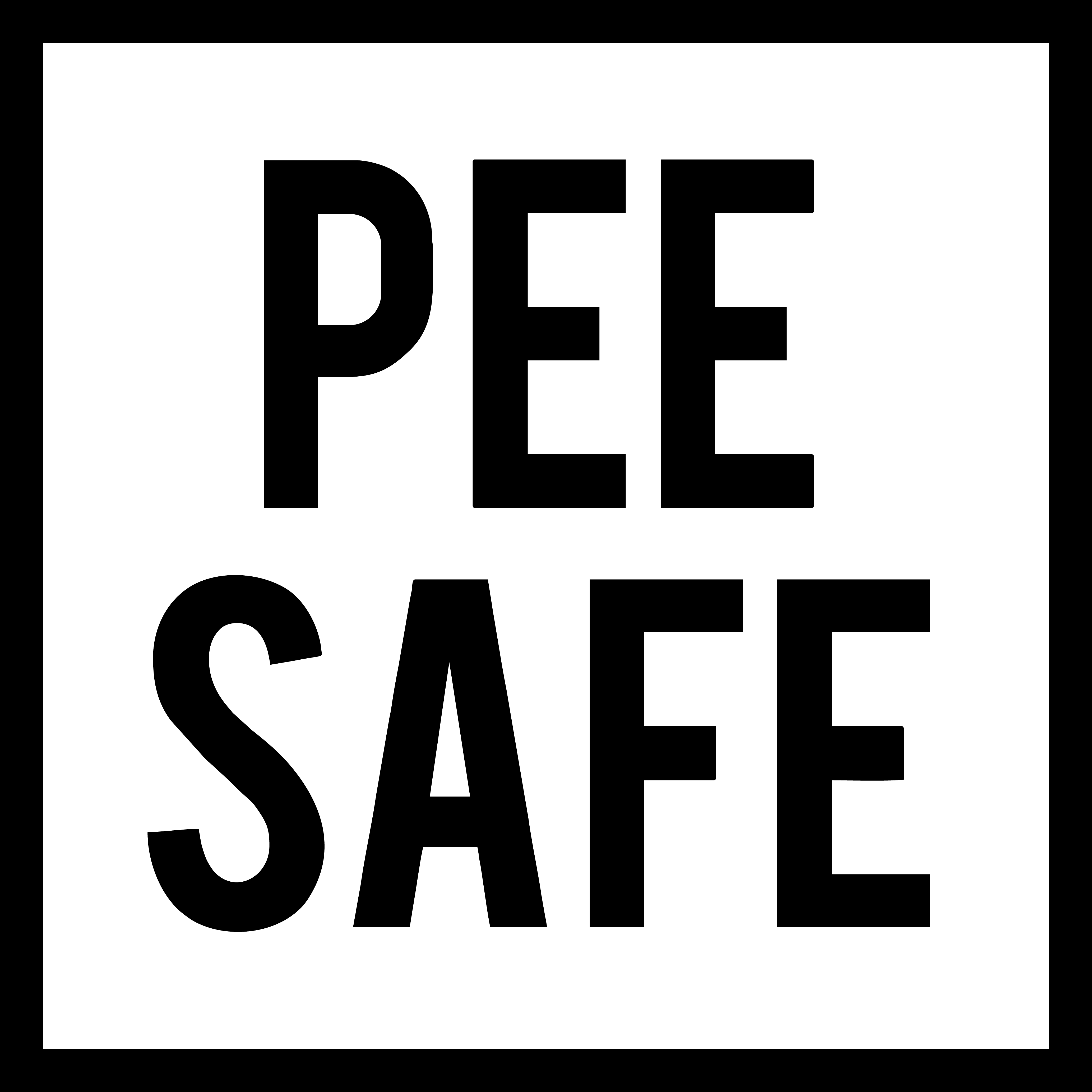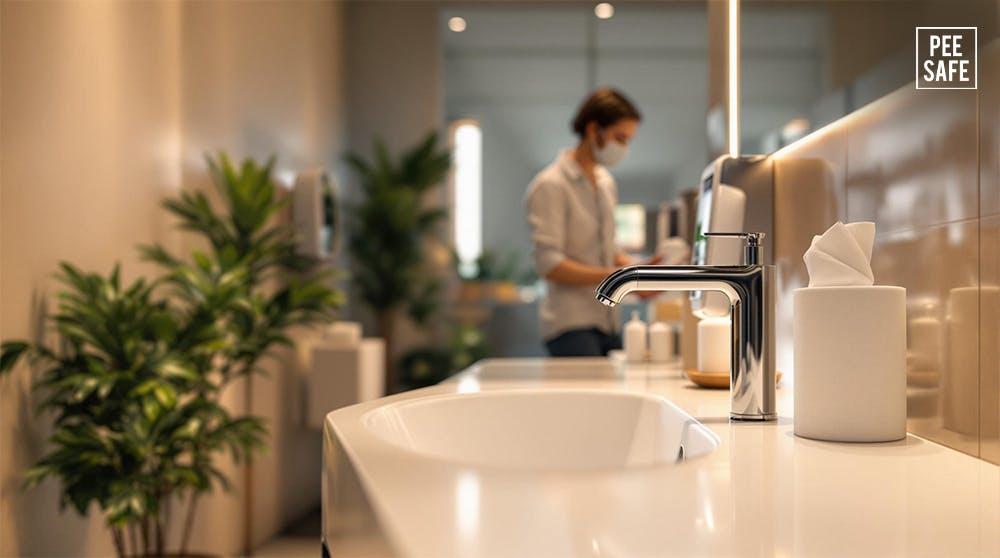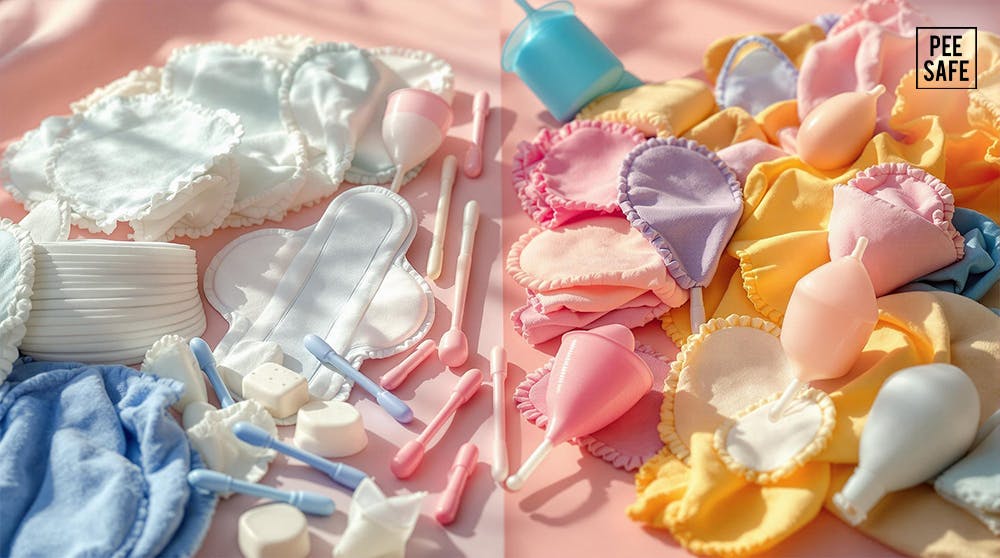Using public restrooms while traveling can expose you to germs and cross-contamination risks. But with a few simple steps, you can stay safe and hygienic. Here’s a quick summary of the 7 essential tips to protect yourself:
- Use Disposable Toilet Seat Covers: Carry sturdy options like ecopolymer covers for added protection.
- Apply Toilet Seat Sanitizer Sprays: Kill 99.9% of germs quickly with travel-size sprays.
- Minimize Contact with High-Touch Surfaces: Use paper towels or elbows for faucets and doors.
- Clean Hands with Soap or Sanitizer: Wash for 20 seconds or use 60% alcohol sanitizers.
- Check Restroom Cleanliness: Assess supplies, floors, and ventilation before use.
- Carry a Travel Hygiene Kit: Include essentials like wipes, sanitizers, and seat covers.
- Keep Emergency Supplies Handy: Pack items like tissues, disinfectant, and resealable bags.
Quick Comparison Table: Hygiene Essentials
| Item | Purpose | Benefits | Drawbacks |
|---|---|---|---|
| Seat Covers | Barrier for toilet seats | Easy to use, disposable | May not fit all seats |
| Sanitizer Sprays | Kills germs on surfaces | Quick-drying, portable | Requires drying time |
| Hygiene Kit | All-in-one preparedness | Compact and versatile | Needs regular restocking |
How To Stay Clean In A Public Restroom
1. Use Disposable Toilet Seat Covers
Disposable toilet seat covers can help shield you from germs in public restrooms. For travelers, they’re a convenient way to stay hygienic when restroom conditions are less than ideal.
Traditional paper covers are easy to find but come with their downsides. For more effective protection, you might want to try ecopolymer film covers. These are sturdier, resist tearing, and come individually wrapped to keep them clean [2].
Here’s a quick comparison of the two options:
| Cover Type | Benefits | Drawbacks |
|---|---|---|
| Traditional Paper | Easy to find, biodegradable | Tears easily, less effective |
| Ecopolymer Film | Durable, stays clean longer | More expensive, harder to find |
It’s a good idea to keep a few disposable covers in your travel bag so you’re always prepared. Just make sure the cover completely covers the seat before use, and dispose of it properly afterward [5].
For extra protection, use a sanitizer alongside the seat cover to reduce exposure to germs even further.
2. Apply Toilet Seat Sanitizer Sprays
Toilet seat sanitizer sprays provide an added layer of protection when using public restrooms. These sprays are designed to kill up to 99.9% of bacteria and viruses on contact, making them a smart addition to your hygiene kit while traveling [1].
When choosing a spray, look for EPA-registered options that target a wide range of germs. Travel-size sprays with quick-dry formulas are especially handy, offering both convenience and effectiveness.
"Practicing good hand hygiene and using additional measures, such as toilet seat sanitizer sprays, significantly reduces the risk of cross-contamination in public restrooms", says Pam Toppel, a hygiene expert at OSF HealthCare [3].
Even if a toilet seat looks clean, it can still harbor germs. Using a sanitizer spray ensures extra peace of mind, especially in crowded or poorly maintained restrooms. Simply spray the seat evenly and wait a moment before sitting. These sprays are particularly helpful when seat covers aren't available or when restroom cleanliness is uncertain.
While protecting the seat is important, try to avoid touching other high-contact surfaces as much as possible.
3. Minimize Contact with High-Touch Surfaces
Public restrooms are full of high-touch surfaces like door handles, flush levers, faucets, and countertops. These areas can harbor bacteria and viruses, so it's important to limit direct contact whenever possible.
Use simple tricks to avoid touching these surfaces directly. For example, try using your elbow to operate faucets or grab a paper towel to open doors. If the restroom has touchless fixtures, take advantage of them - they're a great way to reduce exposure.
"The biggest thing you can do to protect yourself is practice good hand hygiene", says Pam Toppel, Manager of Environmental Services for OSF HealthCare, Eastern Region [3].
If avoiding contact isn't an option, pack some disposable gloves or antimicrobial wipes in your travel kit. For flushing, use foot pedals if available or create a barrier with toilet paper when using your hand.
Be cautious at the sink area, too. Splashing water can carry germs from the basin to your hands or clothes. Stand slightly back to avoid this, and never place personal items like phones or bags on the counter.
Limiting contact with these surfaces is key, but don't forget - keeping your hands clean is just as important.
4. Clean Hands with Soap or Sanitizer
Keeping your hands clean is one of the best ways to protect yourself from germs in public restrooms. While avoiding contact with contaminated surfaces helps, washing your hands thoroughly is key if contact happens.
Use soap and water to wash your hands for at least 20 seconds. Focus on spots people often neglect, like your fingertips, thumbs, and the spaces between your fingers. The technique matters more than the water temperature. If soap isn’t available, a hand sanitizer with at least 60% alcohol is a good alternative, though it won’t remove dirt or certain germs.
Pairing good hand hygiene with tools like seat covers and sanitizers can help you stay safer in public restrooms. A travel-sized sanitizer bottle is handy for on-the-go use. Be sure to take your time, use enough product, and avoid touching dirty surfaces after cleaning your hands.
For travelers, packing both hand sanitizer and wipes can be a lifesaver when facilities are limited. This duo keeps your hands clean without drying them out, even with frequent use.
Clean hands are your first line of defense, but having a well-prepared hygiene kit can make staying germ-free even easier.
sbb-itb-3009f4a
5. Check Restroom Cleanliness Before Use
Before using a public restroom during your travels, take a moment to gauge its cleanliness. Public restrooms are known hotspots for cross-contamination [3], so this quick check can help protect your health.
Here’s what to look for:
- Supplies: Make sure essentials like soap, toilet paper, and paper towels are available.
- Floors: Check for dry, clean floors without puddles or standing water.
- Facilities: Ensure sinks are functional and drainage is working properly.
- Ventilation: Look for good airflow and decent air quality.
Steer clear of restrooms with overflowing trash bins, dirty surfaces, or broken fixtures. If the restroom seems poorly maintained, it’s worth finding another option. Restrooms in transportation hubs or shopping centers are often better kept and may offer a more sanitary experience.
If you have no choice but to use a less-than-clean facility, carrying toilet seat sanitizers can offer added protection. Trust your instincts and use visual cues to decide if a restroom meets basic hygiene standards.
Cleanliness can vary widely depending on the location, so having a well-stocked hygiene kit on hand is a smart move for any traveler.
6. Carry a Travel Hygiene Kit
A travel hygiene kit helps you stay prepared and maintain cleanliness, especially when restroom conditions are less than ideal. While we’ve mentioned several must-have items earlier, organizing them into a compact kit can make your travels smoother.
What to Include:
- Items like hand sanitizers, seat covers, and wet wipes
- Menstrual care products (backup options, pain relief essentials)
- Compact choices such as menstrual cups or discs [4]
- Resealable plastic bags for storing or disposing of used items
| Category | Items to Pack |
|---|---|
| Hygiene Basics | Hand sanitizer, seat covers, spray |
| Personal Needs | Tissues, wet wipes, menstrual products |
| Emergency Supplies | Resealable bags, small first-aid items |
Tips for Packing: Use a water-resistant pouch to store your kit, and choose travel-sized containers to meet airline rules. Brands like Pee Safe offer travel-friendly hygiene products that are worth considering. After each trip, restock your kit and check expiration dates to ensure everything is ready for your next journey.
Keep your hygiene kit within easy reach in your luggage, and clean it regularly to maintain its condition. Being prepared with these essentials means you’ll be ready for any unexpected situations.
7. Keep Emergency Supplies Handy
Being prepared for restroom surprises - like poorly maintained facilities or missing supplies - can save you a lot of stress during your travels. Packing some extra hygiene basics ensures you're ready for anything.
Emergency Items to Pack:
| Category | Items |
|---|---|
| Personal Care | Compact toilet paper roll, wet wipes, tissues |
| Sanitation | Travel-size disinfectant spray, hand sanitizer, antibacterial wipes |
| Medical Needs | Basic first-aid supplies, prescription medications |
| Special Needs | Medical and personal care supplies specific to your requirements |
Keep your emergency kit in a water-resistant bag, stored in an easy-to-reach pocket of your luggage. Use clearly labeled, airline-approved containers for liquids, and include any medical supplies or documentation you might need if you have specific health conditions.
Tips for Packing Smart:
- Pick items that complement your main hygiene kit without repeating what you already have.
- Regularly check and restock your supplies to ensure they're always ready to go.
- Think about your destination and pack items suited to the local conditions.
- Make sure all liquids comply with airline security rules for hassle-free travel.
Conclusion
Traveling often means encountering public restrooms, which can be a hotspot for germs. Being prepared with a hygiene kit and following simple precautions can make a big difference in protecting your health.
Experts warn about the risks of cross-contamination in these spaces, making consistent preventive steps essential. Carrying items like hand sanitizer, disinfectant wipes, and seat covers helps you stay prepared for any situation.
Simple actions - like cleaning your hands thoroughly and using protective supplies - can make restroom visits safer and more manageable. These steps not only safeguard your health but also contribute to cleaner public spaces overall.
FAQs
How can I make my public toilet safe?
Keeping public restroom use safe comes down to a mix of preparation and good habits. Here's a quick rundown of practical steps to protect yourself.
"There is always an increased risk of cross contamination in public restrooms, which in turn can increase your risk of infection from a virus or bacteria. The biggest thing you can do to protect yourself is practice good hand hygiene", says Pam Toppel, Manager of Environmental Services for OSF HealthCare [3].
Key tips for safer restroom use:
- Choose restrooms in clean, well-maintained places like hotels or airports, as they often have higher cleaning standards [3].
- Use paper towels or your elbow to handle doors, faucets, and flush handles [1].
- Use seat covers or sanitizers to create a barrier, as mentioned earlier.
- Close the toilet lid before flushing to minimize airborne particles [1][3].
- Avoid crowded restrooms and wait for others to leave if possible [3].
It's also smart to carry a hygiene kit with essentials like sanitizers and wipes, as highlighted in the "Carry a Travel Hygiene Kit" section. Being prepared makes it easier to handle different restroom situations.
Finally, always wash your hands thoroughly with soap and water. If that's not an option, use hand sanitizer. These straightforward habits, combined with the precautions outlined in this guide, can help you stay hygienic and safe when using public restrooms.




























